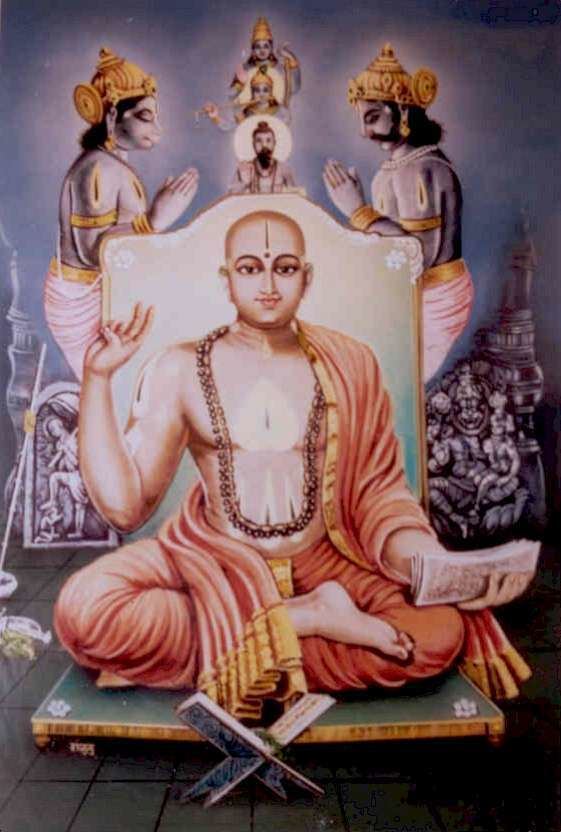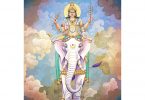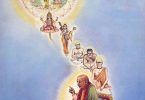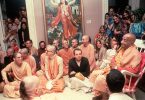Question: We are taught to accept Guru as he represents the disciplic line. I’ve read and heard that guru always speaks without deviation from the previous Acharya in the line. I was wondering about the difference between Sri Madhvacharya and Sri Chaitanya Mahaprabhu. Specifically as it pertains to our line, and the question of authenticity.
Answer by Romapada Swami:
The mandate for a bonafide representative of the disciplic line is indeed, as you say, to speak without deviation from the previous acharyas; but they also present the subject matter according to their own personal realization and according to the needs of the time and audience – this is not a contradiction. This is explained nicely in SB 1.4.1 p. Besides it is the special prerogative of especially empowered acharyas and the Supreme Lord to make such necessary adjustments according to time and place without contradicting scriptural principles and conclusions of previous acharyas. Based on these two considerations, there is actually no difference between Sri Madhvacharya and Sri Caitanya Mahaprabhu.
In a conversation about the apparent difference of opinion among the four principal vaishnava acharyas – Madhva, Ramanuja, Nimbarka and Vishnu Swami – Srila Prabhupada explained that actually there are no contradictions. Despite some minor differences their conclusions are consistent: “There is no difference of opinion, but (each of them) has explained the Absolute Truth more vividly in their own angle of vision. Otherwise there is no difference.” (Lecture on Science of Krsna – Hyderabad, April 14, 1975) And specifically regarding Lord Caitanya, Srila Prabhupada remarked, “No, there is no difference. Rather, Caitanya Mahaprabhu’s teaching is the summary of …all four sampradayas. So Caitanya Mahaprabhu follows everyone.” (Room Conversation with Dr. Copeland, Professor of Modern Indian History – May 20, 1975, Melbourne) As the Supreme Personality of Godhead, Lord Caitanya unified all the four sampradayas – this was demonstrated by Srila Bhaktisiddhanta Sarasvati who installed and honored the deities of all four acharyas in Mayapur. Lord Caitanya took the essential principles of each sampradaya and presented the acintya bheda-abheda philosophy, which is not contradictory to the teachings of Madhvacharya but exemplifies it in its completeness.
Once Srila Prabhupada explained the differences among the five great preachers who appeared in India – Buddha, Sankara, Ramanuja, Madhva and Lord Caitanya: “But you will find a link, a link, although superficially we may see that Lord Buddha is speaking something which is contradictory to Lord Sankaracharya’s teaching, or Ramanujacharya is speaking something which is contradiction to Sankara. No. There is no contradiction. It is the question of studying how they are paving way for ultimate spiritual realization. That requires a very, I mean to say, substantial knowledge, how they are paving the way, just step by step. So these are gradual development so far the human society is concerned.” (Lecture on Bhagavad-gita 2.58-59 – New York, April 15, 1966)
As you have likely heard before, Lord Buddha rejected the Vedas in order to stop unauthorized animal sacrifices and preached non-violence; later on Shankara preached ‘covered Buddhism’ and brought back people under the fold of Vedic authority. Both Sri Ramanuja and Madhva came to defeat the stronghold of Shankaracharya’s Mayavada theory and firmly established Lord Vishnu as the Supreme Person. Later, when the time was appropriate, Srila Madhavendra Puri coming in the same disciplic line as Madhvacharya exhibited symptoms of ecstatic love, which was so far latent in the disciplic line.
The Caitanya Caritamrita explains: “Sri Madhavendra Puri introduced the conception of conjugal love for the first time in the Madhva Sampradaya. This conclusion of the Madhvacarya Sampradaya was revealed by Sri Caitanya Mahaprabhu when he toured Southern India and met Tattvavadis, who supposedly belonged to the Madhva Sampradaya.” (Cc Madhya 4.197) Thus, ‘this conclusion of Madhvacharya sampradaya’ (viz. the conception of ecstatic worship of Radha-Krishna) was not a foreign element but one of the inherent conclusions of Madhvacharya sampradaya later revealed by Lord Caitanya. Likewise, although Madhvacharya established the ultimate goal of transcendentalism to be attainment of pure devotional service, love of Godhead (Cc Madhya 9.11), followers in that sampradaya had accepted the five kinds of liberation as the ultimate goal and varnashrama as the means to achieve it. This is not the conclusion of pure devotional service as Lord Caitanya points out to them during his discussions with the Tattvavadis in His South Indian tour. (Cc Madhya 9.256, 257, 258, 259, and 260).
In summary, the apparent differences viz. Lord Caitanya’s presentation of acintya-bheda-abheda tattva, love of Krishna as the highest goal and the worship of Radha-Krishna in ecstatic love are neither contradictions nor attempts to artificially supercede the teachings of the previous acharyas. Rather, these conclusions were inherently present in Madhvacharya’s teachings but were revealed and perfectly explained only by the mercy of Lord Caitanya and His devotees, when the time was ripe.
Moreover, Sri Caitanya Mahaprabhu is the Supreme Personality of Godhead. He came with a mission of delivering vraja-prema, which was distinct from the mission of Madhvacarya (who is commonly accepted as an incarnation of Vayu), whose primary mission was to solidly refute and defeat mayavada doctrine. As their mission was distinct, so also were their points of emphasis. However, this does not constitute a deviation.
Even the staunch Ramanadis of the Sri Vaisnava sampradaya accepted Sri Caitanya Mahaprabhu and his followers as a bonafide branch of the Madhva line, in one historical debate on this issue in Jaipur; this historical incident demonstrates that it is allowed even in the strictest of forums of vaisnava authority for comprehensive structuring of vaisnava conclusions to represent the vaisnava line from which it descends, with some specific points of emphasis which may not appear to match cent-percent the prior acaryas’ points of emphasis, provided there is a systematic representation of these teachings which follow the Vedanta Sutra codes. This condition was fulfilled by Baladev Vidyabhusana in his Govinda Bhasya, and thus Sri Caitanya Mahaprabhu was accepted by the Ramanadis as fully and authentically representing the Madhva line.







